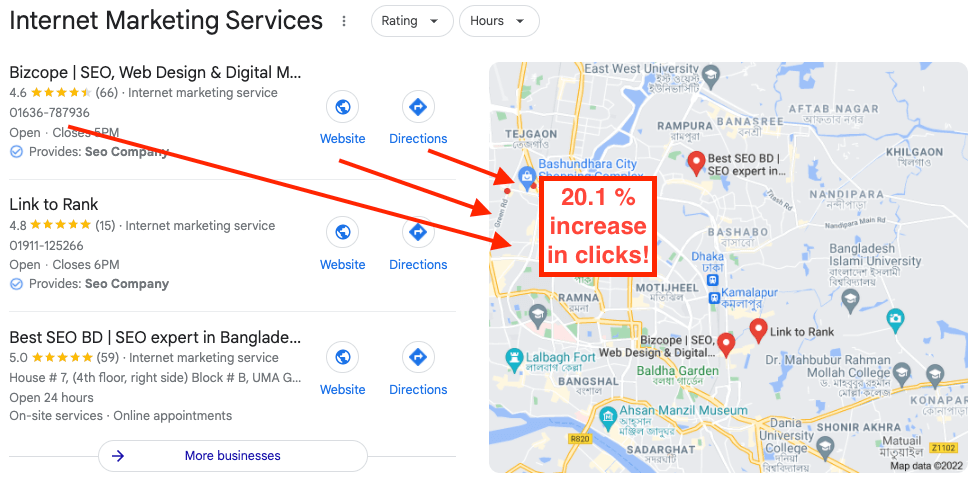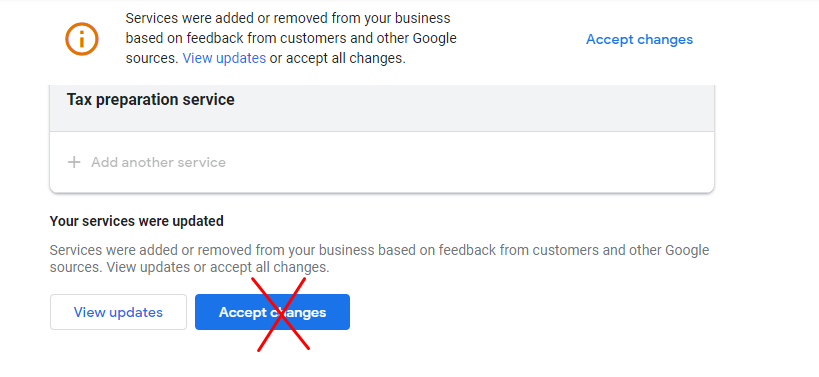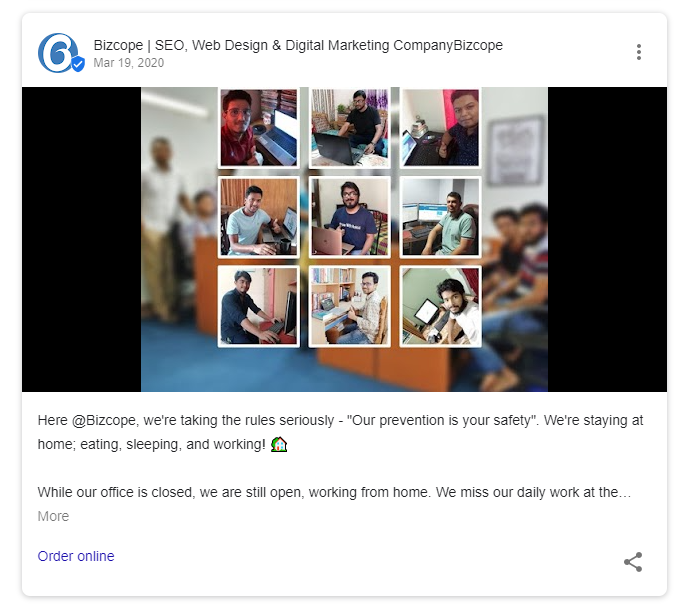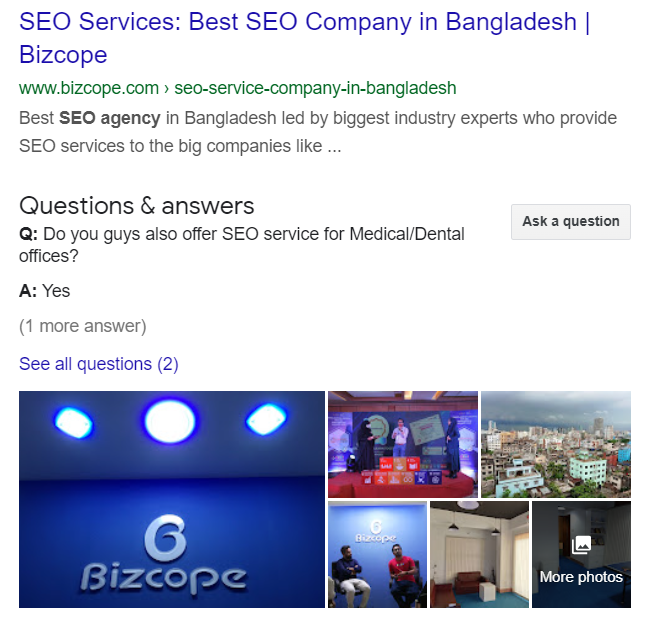Local SEO is a great way to get new inquiries and sales for your local business.
In the United States, an independent study by Search Engine Watch in 2019 found that “There was a 20.1% increase in clicks to call, clicks for directions, and clicks to a business’s website” with GMB interactions when comparing stats from 2017 and 2018.
This is important to take into consideration.

But to get those clicks, your GMB profile must be visible to your prospective customers.
In order to get the most out of Google Maps, we have provided a checklist of GMB optimizations that can help you rank higher in Google Maps search results (Also, check out the Google Spreadsheet Local SEO Checklist).
1. Create your Google My Business profile
Before you can appear on a Google local listing, you’ll need to create your Google My Business profile
You can do that here.
However, if you are running a business for a long while chances are that your business listing has already been created automatically.
In that case, you’ll need to claim your business profile immediately to get the ownership.
If you get the ownership you can control the business profile more efficiently.
Click here to learn how to claim your business.
2. Add your business name, address, and phone number (NAP)
Because local SEO is greatly dependent on your business name, address, and phone number, this information is important to update.
This is because Google displays business listings that are close to them and most relevant to their search queries.
It is important to use your business name as it appears in various places throughout the web. Don’t try to include too many keywords with the business name because Google can detect suspicious activities by its algorithm.
We have discussed more on this with #12 in this checklist, but the point is that when your business is mentioned on other websites, it’s name, address, and phone number should match exactly with your GMB’s name, address, and phone number.
You want to make it as easy as possible for Google to understand that the business that is being mentioned on another website is in fact yours.
To do this, you need to make sure that your name, address, and phone number is uniform across all mentions of your business across the web.
So make sure you set this up correctly from the very beginning when you input this data into your GMB.
3. Relevant Categories
Next, update your category section under “Products” or “Services”.
Here, they allow you to have a “primary” category as well as “additional” categories.
This is very important because by optimizing the category section with proper keywords you can directly communicate to Google what your business is all about.
Choose the single best term that describes your business in the primary category, then add more categories in the additional categories section.
4. Service areas
Next, update your service areas.
You can add one or more service areas. For example, if you serve in New York you can choose:
- New York, NY, USA
- Bronx, NY, USA
- Queens, NY, USA, and many more
This will allow your target customers to find you more easily.
5. Operating hours
Next, set your operating hours very carefully.
This is because people will see your business listing CLOSED when you are not an in-service hour.
Check your Google My Business profile frequently as your operating hour can automatically get changed by the users.
6. Website and appointment URL
Next, update your
- website URL, and
- appointment URL
Be careful while updating the URLs because if you don’t input the correct URL you’ll lose your visitors to your website.
For instance, if your URL doesn’t contain “www” don’t use “www” in the URL.
Your website URL should be:
- the Home Page URL,
Whereas, the appointment URL should be
- the contact page URL, or
- the page where a contact form is available, or
- any other URL that you use for client schedule; for instance, calendly.com.
7. Add Specific services
You’ll find this option under the “Services” tab or menu on the sidebar.
In this section, you can add specific services under each category.
For example: if you are an accountant, you can add “Business Tax Preparation” as one service and “Small Business Accounting” as another.
By doing this, interested searchers will find your business listing on the search results, and be interested to click through to your website.
8. View Updates / Review Suggestions by Users
Very Important: If you are running a business for a long while you may get a notification like that
“Services were added or removed from your business based on feedback from customers and other Google sources. View updates or accept all changes.”

This happens because Google users suggest some changes to your GMB account.
Anyone on the internet can suggest adding or removing certain services.
So, never accept those changes without reviewing those suggestions.
Never click the button “Accept Changes”.
To review the suggestions, always use the button “View Updates”
9. Keyword-rich description
You will find this option inside the “Info” tab or menu on the left sidebar.
You are allowed to write a business description only up to 750 characters that appear on the search results on your business listing.
So, the write-up should be well-tailored both for humans as well as for Google Algorithm.
That means, use as many keywords as possible to make a well-written business description that is also human-readable.
By doing this, Google can understand what your business is all about and what type of searches it should show your profile for.
So, you are increasing your chances of ranking for your target keywords.
10. GMB posts
GMB Posts are micro-blogging posts, which allow you to publish events and share your products or services directly in Google search results and Maps.
Only a small percent of businesses are currently taking advantage of Google My Business posts.
It may look like this:

You can choose one of these post types to get started:
- What’s New Posts
- Events posts
- Offers posts
- Products posts
You can place your most important keyword in your Google My Business post to make it easier to rank for that phrase.
11. Reviews
Google customer reviews are a great way to show how fantastic your business can be, considering that many consumers research online before making a purchase decision.
Your reviews provide a somewhat all-inclusive idea about your business/service.
However, you should keep in mind that it is not a one-time set-up arrangement;
You cannot set up your Google My Business listing for foot traffic and website visitors and forget about it.
Unless you play an active role in managing your GMB listing and reviews, you’re likely to find that negative reviews pile up on their own while positive reviews get overlooked.
12. Photos and video

Photos and videos highlight features of your company that customers consider before making a purchase.
Google recommends that businesses add multiple types of photos to make a strong profile:
- Interior Photos such as a workspace, teamwork, reception area, or waiting room.
- Exterior Photos taken from multiple angles at different times of the day (at least 3 photos)
Uploading photos and/or videos to your GMB profile will increase your ranking and help you stand out among your competitors.
13. Local and NAP citations
As stated in #2, having a consistent business name, address, and phone number across the web is crucial to your GMB rankings.
Once we update the NAP information on GMB, now it’s time to actually go out and put this NAP information on other websites.
How do we do this?
We list our business on as many local, relevant directories as possible.
Listing your business on such directories with your NAP information and a link back to your website will make it appear that the information on this linking page is relevant to your site.
These types of links are called “citations”.
And the higher the number of citations that we get pointing back to our site, the more our local relevance will become established in Google’s eyes.
Click the following link if you would like to learn more about NAP citations.
Conclusion
If you start implementing this basic checklist, you should start observing traffic flow through your Google Map.
However, like organic SEO, Google Map SEO is also not a one-time setup.
You should regularly test different factors and track the progress in traffic and ranks.
If you invest in Google Maps marketing, it is very much possible to drive local leads to your business with consistency.
If you would like to ask any questions about this post, comment below and I’ll answer them.

